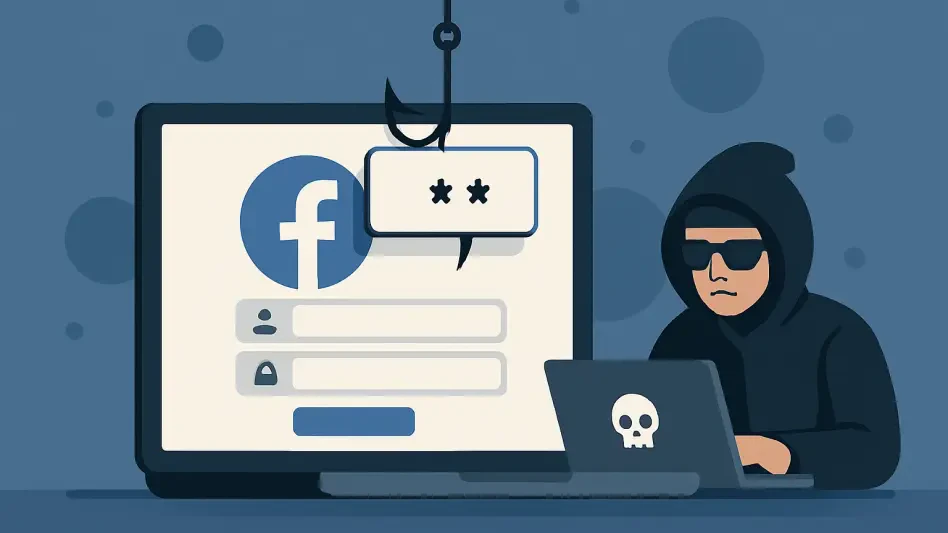In an era where digital connectivity is paramount, the alarming rise of sophisticated phishing campaigns targeting social media users has become a pressing concern for millions worldwide. Cybercriminals have honed their tactics to exploit the trust placed in platforms like Facebook, crafting deceptive schemes that steal personal information with alarming precision. These attacks are not just random attempts but carefully orchestrated efforts that leverage both technical ingenuity and psychological manipulation to bypass security measures and user skepticism. As the digital landscape continues to evolve, understanding the mechanisms behind these threats is crucial for safeguarding online identities. This article delves into a recent phishing campaign that has set a new benchmark for deception, exploring the innovative methods used by attackers to compromise user credentials and the broader implications for online security.
Unveiling the Sophisticated Phishing Tactics
Exploiting Trusted Redirect Systems
A particularly insidious aspect of this phishing campaign lies in how attackers manipulate Facebook’s external URL warning system to mask their malicious intent. By routing phishing links through the platform’s legitimate redirect service, known as l.facebook.com, cybercriminals create an illusion of authenticity that tricks users into believing the links are safe. These deceptive URLs are embedded in emails that mimic urgent security notifications, complete with familiar branding and disclaimers, urging recipients to take immediate action to secure their accounts. The use of multiple languages, including English, German, Spanish, and Korean, ensures that the campaign reaches a diverse global audience, amplifying its potential impact. This clever exploitation of a trusted domain not only evades detection by email security gateways but also lowers the guard of even the most cautious individuals, making it a formidable challenge for traditional security tools to identify and block.
The technical prowess behind this method is further highlighted by the seamless integration of redirects that lead users to counterfeit login pages. Once a link is clicked, the victim is directed to a site that closely resembles Facebook’s official interface, complete with familiar design elements that reinforce the illusion of legitimacy. Here, unsuspecting users are prompted to enter their credentials, including email addresses, phone numbers, and passwords, which are then harvested and transmitted to a command-and-control server through a hidden PHP script. This process is designed to be swift and discreet, ensuring that victims remain unaware of the breach until it’s too late. The reliance on a trusted redirect system underscores a growing trend in cybercrime where legitimate services are weaponized to enhance the credibility of malicious campaigns, posing significant hurdles for both users and security professionals striving to stay ahead of these threats.
Psychological Manipulation Through Urgency
Beyond the technical intricacies, the success of this phishing campaign heavily relies on exploiting human psychology through carefully crafted messages that evoke a sense of urgency. The emails sent to potential victims are designed to mimic official communications from Facebook, often warning of account suspension or unauthorized access attempts that require immediate attention. This tactic preys on the natural instinct to protect one’s digital presence, prompting users to click on links without thoroughly vetting their authenticity. The multilingual nature of these messages further broadens the scope, ensuring that individuals from various linguistic backgrounds are equally susceptible to the ruse. Such psychological manipulation is a cornerstone of modern phishing strategies, as it bypasses rational scrutiny and drives impulsive actions that play directly into the hands of cybercriminals.
Another layer of deception is added through the use of a JavaScript snippet on the fake login pages, which displays an “Incorrect password” error after the initial credential submission. This prompts users to re-enter their details, often leading to the submission of valid information on the second attempt as doubt and frustration set in. Following this, a second redirect to the legitimate Facebook site, accompanied by a generic error notice, further reduces suspicion, as victims may attribute the issue to a temporary glitch rather than a malicious act. This calculated sequence of events showcases how attackers combine technical tricks with psychological ploys to maximize their success rate. It serves as a stark reminder of the need for heightened awareness and critical thinking when encountering unexpected digital communications, especially those that demand urgent responses under the guise of security concerns.
Addressing the Evolving Threat Landscape
Strengthening User Awareness and Vigilance
Reflecting on the mechanics of this phishing campaign, it becomes evident that user education plays a pivotal role in mitigating such threats. Many fall victim to these attacks due to a lack of awareness about the subtle cues that distinguish legitimate communications from fraudulent ones. Historical efforts to combat phishing often focused on teaching users to scrutinize email senders, verify URLs before clicking, and recognize the hallmarks of urgency-driven scams. Past initiatives demonstrated that informed users were less likely to engage with suspicious links, even when they appeared to originate from trusted sources like Facebook. The emphasis on vigilance proved essential, as it empowered individuals to act as the first line of defense against increasingly sophisticated cyber threats that leverage both technology and human behavior.
Moreover, past responses to similar campaigns highlighted the importance of fostering a culture of skepticism toward unsolicited digital interactions. Cybersecurity awareness programs in previous years often encouraged users to double-check the authenticity of any security alerts by directly accessing their accounts through official channels rather than clicking on provided links. This proactive approach significantly reduced the likelihood of credential theft, as it disrupted the attackers’ reliance on impulsive reactions. By revisiting these strategies, it is clear that reinforcing user awareness with practical, actionable advice remains a cornerstone of defense against phishing. The lessons learned underscore that while technology evolves, the human element continues to be a critical factor in maintaining online safety amidst a landscape of ever-changing threats.
Enhancing Technological Defenses
Looking back, the battle against phishing attacks targeting platforms like Facebook revealed a pressing need for robust technological safeguards to complement user education. Security experts in past efforts prioritized the development of advanced email filtering systems that could detect and flag malicious URLs, even when masked by legitimate redirect services. These systems, honed over time, became more adept at identifying patterns of deception, such as the use of multilingual phishing emails or subtle discrepancies in branding. By integrating machine learning algorithms, previous technological defenses adapted to the evolving tactics of cybercriminals, offering a proactive shield against campaigns that exploit trusted domains to evade traditional detection methods.
Additionally, historical advancements in browser security features proved instrumental in curbing the impact of such phishing schemes. Features like real-time URL scanning and warnings about suspicious sites helped alert users before they could input sensitive information on counterfeit pages. Collaborations between social media platforms and cybersecurity firms in the past also led to quicker identification and takedown of malicious domains, disrupting the infrastructure that supported these attacks. As a forward-looking step, continuing to invest in cutting-edge detection tools and fostering partnerships between tech giants and security experts will be crucial. These combined efforts ensure that the digital ecosystem remains resilient, offering users a safer online experience while staying ahead of cybercriminals who relentlessly refine their deceptive practices.








